Biomedical Engineering Reference
In-Depth Information
These changes directly affect the amount of filling of the ventricle, denoted
. Stroke
volume increases with increased preload, and vice versa. As the ventricle is filled more, the
end-diastolic volume shifts to the right and the work loop area increases due to the Frank-
Starling mechanism. In essence, increased filling stretches the constituent heart muscle,
which allows the muscle to generate more force via the force-length relation, the direct
relation between muscle length and maximum force of contraction (up to a point). There
is also a small shift of end-systolic volume to the right with increased preload. As the heart
ejects more blood (SV), the load against which the heart must work is increased.
Figure 4.49 shows work loops for the same ventricle and arterial load for direct varia-
tions in
preload
, the load against which the ventricle pumps. Afterload changes were
achieved by varying the value of arterial peripheral resistance
afterload
. Stroke volume decreases
as afterload is increased due to the underlying force-velocity relation of muscle. Higher
peripheral resistance forces muscle to operate at a lower velocity of shortening, so less time
is available for the ventricle to eject blood. Figure 4.49 shows a small shift of end-diastolic
volume to the right with increased afterload. Since stroke volume is reduced, there is
remaining blood available for the next heartbeat. This effect is more pronounced in the
natural system, which can be examined by extending the model as follows.
The left ventricle model of Eq. (4.75) was used to describe each of the four chambers of the
human heart, depicted in Figure 4.50 [25, 23]. This complete model of the circulatory system
displays a remarkable range of cardiovascular physiology with a small set of equations and
parameters. Changes in blood vessel properties may be studied alone or in combination with
altered heart properties. Other system parameters such as atrial performance, as well as other
experiments, may be examined. The modular form of this model allows its expansion for
more detailed studies of particular sites in the circulatory system.
Figure 4.51 shows work loops computed for the left ventricle in the complete circulatory
system model for three different preloads, achieved by increasing and decreasing total
R
S
160
140
+50% afterload
120
control
100
-50%
80
60
40
20
0
50
75
125
Ventricular Volume V
LV
[ml]
100
150
FIGURE 4.49
Pressure-volume work loops computed for the human left ventricle (Eq. (4.75)) and arterial load
(Figure 4.37) for control and varied afterload, achieved by varying peripheral resistance
R
S
.


































